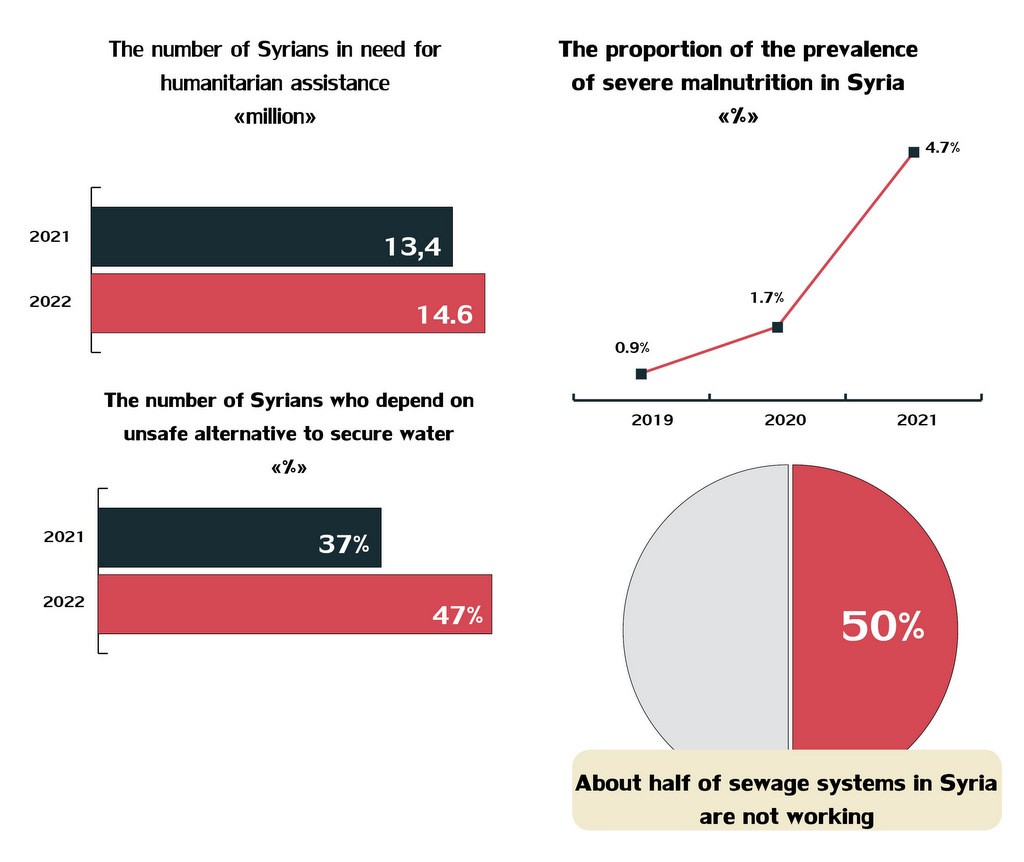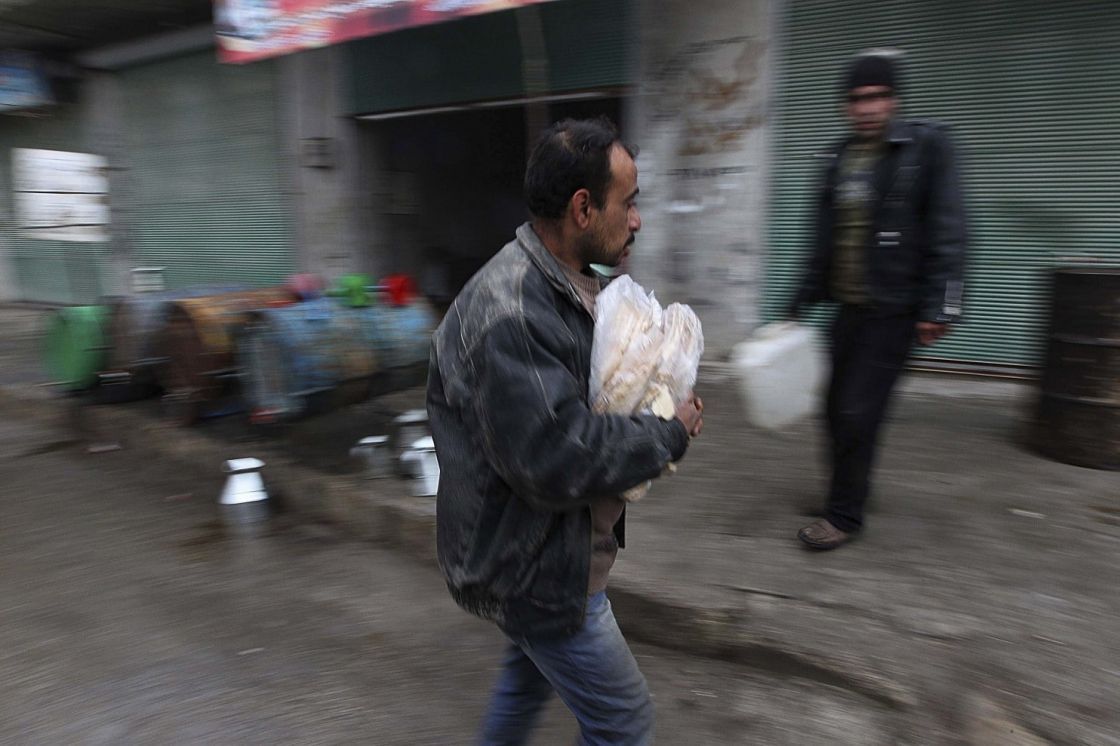- Articles
- Posted
The Continuously Growing Destitution in Syria
Eleven years after the outbreak of the crisis in the country, humanitarian needs are still aggravating in Syria, given the long-term consequences of the wide spread destruction of infrastructure across the country. In addition to the acceleration of the economic downturn that began before the crisis erupted, and grew in frequency during it, causing Syria to become the country with the most internally displaced people in the world.
In this context, the United Nations Office for Coordination of Humanitarian Affair has recently issued an analysis that included an overview of the humanitarian needs in the country for 2022, revealing the developments of some aspects of economic deterioration that affected them. The number of Syrians in need for humanitarian assistance has jumped from 13.4 million citizens in 2021 to 14.6 million citizens in 2022, i.e., an additional 1.2 million citizens are now in need for humanitarian assistance within one year only.
Economic Deterioration at All Levels
The analysis indicated that all macroeconomic indicators have deteriorated during 2021, and got worse, leading to depreciation in the national currency, higher commodity prices in the market, lower State financial revenues, and higher domestic debt. These factors combined have led to massive losses in livelihood and inundating additional segments of the population with humanitarian needs. This has not only affected regions that have witnessed clashes and battles, but also the regions least affected with military action.
In addition, in 2021, climate shocks and negative impacts on natural resources, especially water, have intensified. Irregular rainfall – alongside historically low water levels in Euphrates River – have not only reduced access to safe drinking and domestic usable water for more than 5 million people, but also have caused significant losses in crops and agricultural income, reduced hydropower generation, and increased water-borne diseases. It is expected for these developments on the medium and long term to have a dangerous and cumulative impact on health, cause food insecurity, and high malnutrition rates, in addition to potentially irreversible consequences.
Growing Needs of 6.9 Million Displaced Person
The long-term needs for an estimated 6.9 million internally displaced person are significantly exacerbating, especially for the more than 2 million people in about 1760 unofficial gatherings and camps. In general, internally displaced people mostly live in places where they are not provided with factors of sufficiency, and do not have access to basic services. While those who have returned to their original residence – the majority of which have been destroyed – are facing significant challenges in meeting their basic needs.
The deterioration of the economic situation have a severe bad impact on almost all of the country’s population. According to the estimates of the United Nations, the group which shows the highest level of need currently is the group that has not been displaced previously, which strongly indicates that economic downturn today is the main driver of needs in regions that are less directly affected by hostilities. The number of people in need among those have increased from 6.4 million in 2020 to 9.2 million in 2021.

Increased Dependence of Families on Women
The ability of people in general to meet the basic needs in 2021 have significantly decreased compared to 2020, with an aggravated and increasing impact on households headed by women, the elderly without family support, disabled people, and children. The data of multisector needs assessment during 2021 indicates that the income gap has continued to widen everywhere, despite the fact that 64.1% of households reported that one member of the family (at least) is a wage earner. Over the past year, Syria has seen a rapid increase in the number of “poor workers”, which has significantly contributed to the increase in the number of people in need in 2022. Syrian families across the country have adopted negative coping mechanisms more frequently than before. This included child labor, child marriage in order to get rid of their costs of living, selling productive assets, etc. All these mechanisms severely increase the need to support families, and reduce the ability of families to be self-reliant in the future.
Food Insecurity and the Intentions of Displaced People
Food insecurity remains extremely high across the country; as with an estimated 12 million people suffering from sever food insecurity, Syria is ranked among the top 10 most food insecure countries worldwide by mid-2021. According to the latest surveys of the intention of internally displaced people to return to their regions, the majority of displaced families intend or expect to stay at their current position within the next 12 months. On the other hand, one-third of those families have not yet decided whether to relocate or return to their original residence. The factors that affect the decision of people include the security situation, lack of livelihood opportunities, the deterioration of economic situation and humanitarian assistance, etc.
Attrition of Competencies is One of the Biggest Problems
People’s access to basic needs across the country continues to decline due to damaged infrastructure, lack of vital supplies, and low purchasing power, in addition to the challenges regarding freedom of movement and safety. One of the most urgent concerns is the lack of staff needed to provide and maintain basic healthcare services, or to operate drinking water supply systems, as a result of displacement, death, or disability, and lack of technical training. Hence, half of Syria's governorates are in a state of emergency due to lack of healthcare workers.
Pre-war
According to the analysis, electricity levels, which are considered critical to providing services, healthcare, and livelihood, now reach 15% of what they used to be before the crisis erupted in 2011. Water treatment and distribution systems are still deteriorating – as 47% of Syrians now often depend on unsafe alternatives to piped water, up from 37% in the previous year. At least 70% of sewage is discharged untreated, and at least half of the sewage systems are not working, while water-borne diseases continue to increase.



